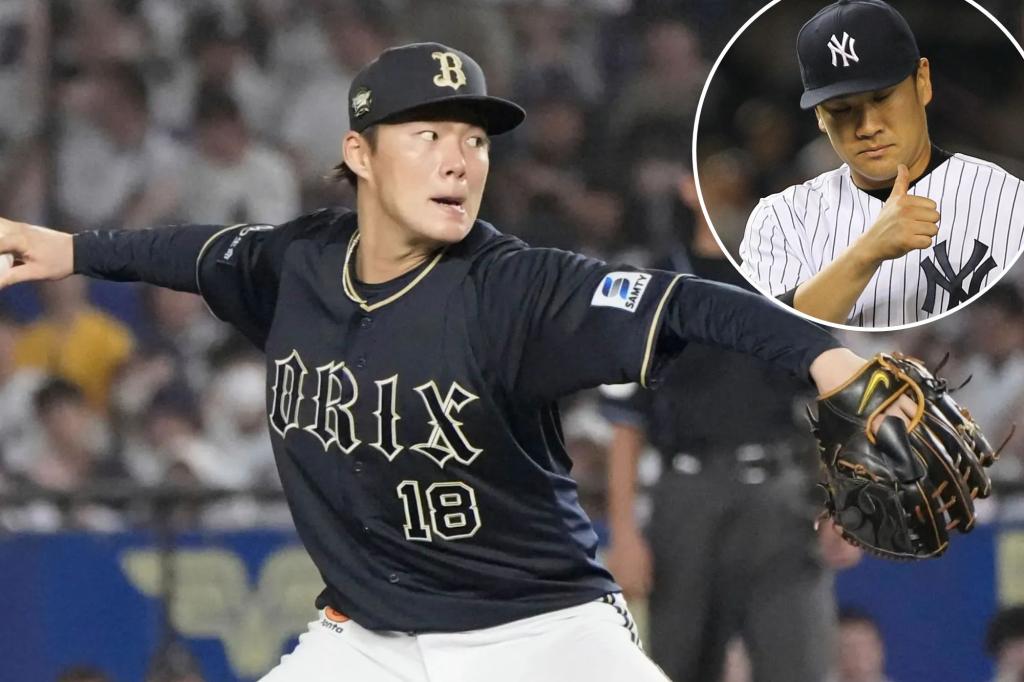Six years ago, the Yankees were eliminated from the Shohei Ohtani sweepstakes before the second round even began, when general manager Brian Cashman said they learned Ohtani preferred to sign with a West Coast team.
Now the two-way superstar Ohtani is a free agent again, as is likely the best starting pitcher to head to MLB from Japan since then, Yoshinobu Yamamoto.
The right-handed Yamamoto just turned 25 in August and is coming off of three straight sub-2.00 ERA seasons for the Orix Buffaloes in Nippon Professional Baseball.
He went 17-6 with a 1.16 ERA and a WHIP of 0.860 in 171 innings this season.
In some ways, Yamamoto is more like the Yankees’ last big signing from Japan, Masahiro Tanaka, who came to The Bronx a decade ago with much fanfare and a seven-year, $155 million contract, with an additional $20 million posting fee.
Tanaka was the last major player the Yankees have signed from Japan, and there are plenty of reasons to believe Yamamoto could be the next one.
For one thing, a potential Ohtani contract could exceed $500 million, even with Ohtani unable to pitch in 2024 after undergoing Tommy John surgery. Yamamoto is expected to get a deal that may exceed $200 million over seven or eight years.
And if the Yankees liked Tanaka’s resume from Japan, Yamamoto’s is strikingly similar.
In Tanaka’s final season with Rakuten as a 24-year-old, he went 24-0 with a 1.27 ERA and a WHIP of 0.943 in 212 innings.
Yamamoto has a full arsenal of pitches and features a splitter, similar to the one thrown by Tanaka and, more recently, Ohtani. He’s also known for a particularly picturesque — and nasty — curveball.
Unlike the bigger Tanaka and Ohtani, though, Yamamoto is listed at just 5-foot-10 and 176 pounds.
When you consider that Tanaka’s phenomenal first season with the Yankees in 2014 was disrupted by a partial tear of his UCL and Ohtani is on his second Tommy John surgery, it’s fair to wonder whether Yamamoto has a similar injury risk.
Still, just as the Yankees needed help in the rotation prior to Tanaka’s arrival, the same is true now.
There’s Gerrit Cole, coming off his first Cy Young season, and then a lot of uncertainty.
Carlos Rodon is coming off a disastrous first season in The Bronx, and his six-year, $162 million deal could well turn into a fiasco. Nestor Cortes had a disappointing, injury-filled 2023.
Then there are Michael King and Clarke Schmidt, right-handers with promise who haven’t shown an ability to be more than middle-of-the-rotation starters and have questions about their workloads. Behind them are young arms such as Randy Vasquez and Will Warren, among others.
Making matters perhaps even more complicated is that Cole can opt out of the final four years of his nine-year contract following the upcoming season.
Cole politely declined to discuss that possibility both in spring training and during the regular season. Even if he did exercise the opt-out, the Yankees could negate it by adding another year and $36 million to the deal, which would keep Cole a Yankee through the 2029 season.
The 33-year-old Cole dominated last year, but the recent track record of AL Cy Young Award winners pitching to a similar level the following year isn’t great. Corey Kluber was the last to come close in after winning the Cy Young in 2017.
Looking for lefties
One of the reasons the Yankees had their worst season in decades in 2023 was a structural flaw in the offense.
The Yankees became too reliant on right-handed hitters, which is among the reasons they are interested in free agent Cody Bellinger.
Bellinger is not only a productive outfielder, but he would provide a much-needed lefty bat. Padres star Juan Soto is a possible trade target for the same reason.
Just how right-handed have the Yankees become in recent years?
They had the second-fewest at-bats from left-handed hitters last season (ahead only of the Astros), and the at-bats they got weren’t good. They finished 29th in batting average by lefties (.219), 27th in OPS (.673) and dead last in the majors in on-base percentage (.295).
And though last year was especially striking in that regard, it was part of an ongoing trend.
In 2022, the Yankees ranked 24th in left-handed at-bats and 28th in batting average — though they were seventh in lefty OPS that year.
The numbers were worse in ’21: 28th in at-bats, 30th in batting average and 26th in OPS.
The Yankees have finished in the bottom half in at-bats for lefties each season since they were second in the majors in 2016.
That’s when an argument was made that they had veered too far to the other side, when they had Brian McCann, Didi Gregorius, Brett Gardner and Jacoby Ellsbury — and even Dustin Ackley, for a time — all hitting from the left side, as well as switch-hitters Chase Headley, Mark Teixeira, Aaron Hicks and Carlos Beltran.
Ausmus’ biggest Yankee moment
Brad Ausmus, named Aaron Boone’s bench coach this week, will have a hard time topping his most influential contribution to the Yankees, no matter what he does in his new role.
Ausmus was drafted by the organization in the 48th round out of Cheshire Academy in Connecticut in 1987, but never got to the majors with the Yankees.
Instead, after finishing the 1992 season with Triple-A Columbus, Ausmus was selected by the Rockies in the expansion draft, which prevented other Yankees prospects from being selected.
Dave Dombrowski, then the general manager of the Florida Marlins, has said he was prepared to take Mariano Rivera, who was with High-A Fort Lauderdale, in the draft before the Yankees were able to pull him back due to Ausmus’ selection.
Ausmus was traded the following season by the Rockies to the Padres and had a solid 18-year major league career — nearly as long, but not quite as historic, as Rivera’s.
Source









